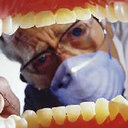[Study on total glucosides of peony preventing non-obese diabetic mice from sialoadenitis].
Mots clés
Abstrait
OBJECTIVE
To investigate the immunosuppressive effect of total glucosides of peony (TGP) on sialoadenitis in non-obese diabetic mice (NOD mice) and explore its possible mechanism.
METHODS
27 female five-week-old NOD mice were randomly divided into three groups: TGP, hydroxychloroquine (HCQ) and normal saline (NS) group. One week later, they were administered intragastrically in TGP, HCQ and NS respectively. Three mice from each group were sacrificed at the age of 10, 15 and 20 weeks. The saliva flow, serum and submandibular glands were collected at these time points. Histological changes of submandibular glands were examined by HE staining. The expression of autoantibodies (SSA, SSB and anti-alpha-fodrin) and associated cytokines in serum were detected by enzyme-linked immunosorbent assay (ELISA).
RESULTS
Compared with the NS group, salivary flow was significantly increased, the extent of the histological changes were ameliorated, the autoantibodies in serum were significantly decreased and the imbalance of Th1/Th2 cytokines was remedied in the mice treated with TGP and HCQ. There were no significant differences between the two groups treated with TGP and HCQ (P > 0.05).
CONCLUSIONS
TGP can effectively ameliorate sialoadenitis on NOD mice. The mechanism was thought to be associated with the protection of submandibular gland from intense inflammation and the correction of Th1/Th2 cytokines imbalance.



